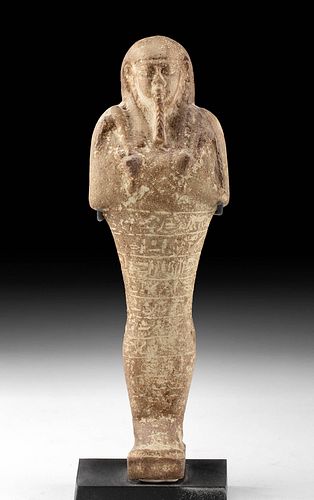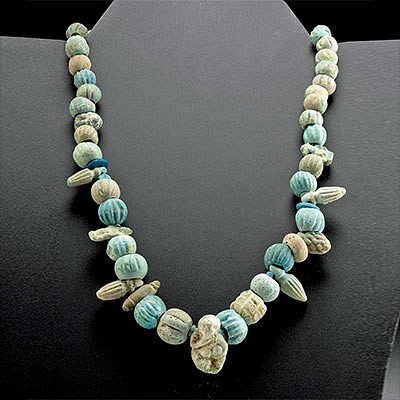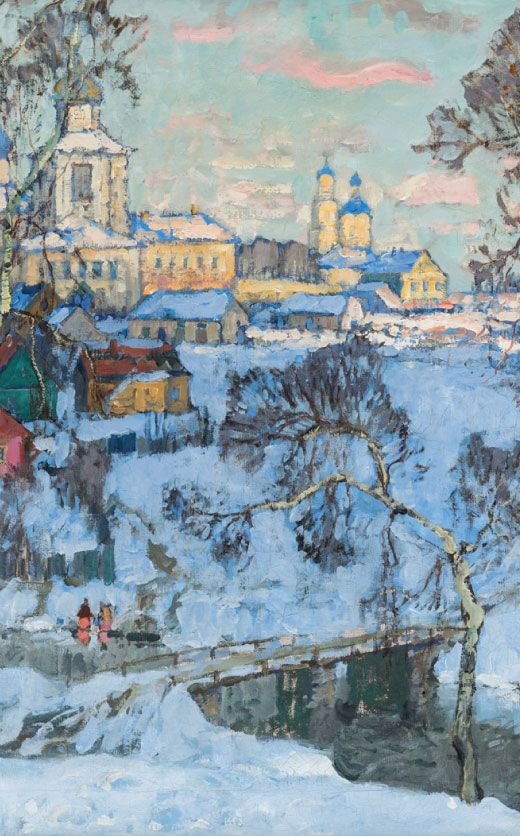Egyptian Glazed Faience Ushabti for Djehoti
Lot 2
About Seller
Artemis Fine Arts
686 S Taylor Ave, Ste 106
Louisville, CO 80027
United States
Selling antiquities, ancient and ethnographic art online since 1993, Artemis Gallery specializes in Classical Antiquities (Egyptian, Greek, Roman, Near Eastern), Asian, Pre-Columbian, African / Tribal / Oceanographic art. Our extensive inventory includes pottery, stone, metal, wood, glass and textil...Read more
Estimate:
$4,000 - $6,000
Absentee vs Live bid
Two ways to bid:
- Leave a max absentee bid and the platform will bid on your behalf up to your maximum bid during the live auction.
- Bid live during the auction and your bids will be submitted real-time to the auctioneer.
Bid Increments
| Price | Bid Increment |
|---|---|
| $0 | $25 |
| $300 | $50 |
| $1,000 | $100 |
| $2,000 | $250 |
| $5,000 | $500 |
| $10,000 | $1,000 |
| $20,000 | $2,500 |
| $50,000 | $5,000 |
| $100,000 | $10,000 |
| $200,000 | $20,000 |
About Auction
By Artemis Fine Arts
Mar 4, 2021
Set Reminder
2021-03-04 10:00:00
2021-03-04 10:00:00
America/New_York
Bidsquare
Bidsquare : Ancient | Ethnographic Art Through The Ages
https://www.bidsquare.com/auctions/artemis-gallery/ancient-ethnographic-art-through-the-ages-6467
Ancient art from Egypt, Greece, Italy and the Near East, as well as Asian, Fossils, Pre-Columbian, Native American, African / Tribal / Oceanic, Fine art, and much more! All categories, all price ranges... all legally acquired and guaranteed to be as described or your money back. Artemis Fine Arts info@artemisfinearts.com
Ancient art from Egypt, Greece, Italy and the Near East, as well as Asian, Fossils, Pre-Columbian, Native American, African / Tribal / Oceanic, Fine art, and much more! All categories, all price ranges... all legally acquired and guaranteed to be as described or your money back. Artemis Fine Arts info@artemisfinearts.com
- Lot Description
Egypt, Late Dynastic Period, 29th to 30th Dynasty, ca. 398 to 343 BCE. A grand funerary figure known as an ushabti that was mold-formed from lightweight faience and enveloped with blue-green glaze at one time. The imposing figure stands in mummiform with legs fused atop an integral rectangular plinth, holds a relief pick and hoe in hands crossed atop the bulging chest, and carries a seed bag behind the left shoulder. The countenance is comprised of almond-shaped eyes with elongated canthi, indented mouth corners above a plaited false beard, and cupped ears framed by the lappets of the tripartite wig. Incised across the legs and lower body are 10 lines of hieroglyphic text that, when translated by Carole Andrews at The British Museum, identify this figure as "PAMER(?)LN also known as DJEHOTI." Size: 2.3" W x 7.6" H (5.8 cm x 19.3 cm); 8" H (20.3 cm) on included custom stand.
Provenance: private Jones collection, Boulder, Colorado, USA, purchased in September 2013; ex-Artemis Gallery; ex-private G. Bingham collection, Utah, USA before 2000
All items legal to buy/sell under U.S. Statute covering cultural patrimony Code 2600, CHAPTER 14, and are guaranteed to be as described or your money back.
A Certificate of Authenticity will accompany all winning bids.
We ship worldwide and handle all shipping in-house for your convenience.
#160594Extensive fading to original glaze color, with abrasions and softening to body, facial details, and hieroglyphic inscription, and chipping to nose, hands, and held implements, otherwise intact and excellent. Great preservation to overall form.Condition
- Shipping Info
-
All shipping is handled in-house for your convenience. Your invoice from Artemis Gallery will include shipping calculation instructions. If in doubt, please inquire BEFORE bidding for estimated shipping costs for individual items.
-
- Buyer's Premium



 EUR
EUR CAD
CAD AUD
AUD GBP
GBP MXN
MXN HKD
HKD CNY
CNY MYR
MYR SEK
SEK SGD
SGD CHF
CHF THB
THB














